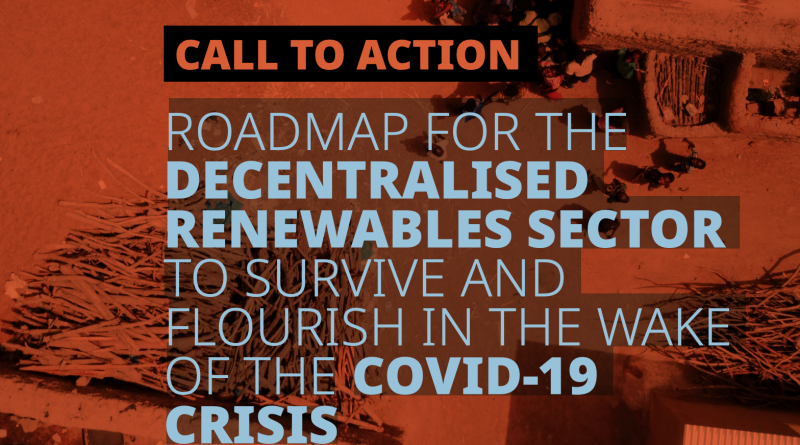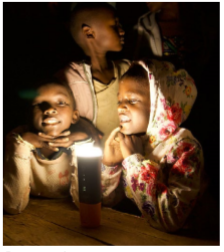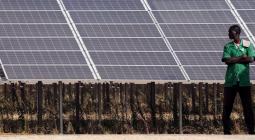Call for Action!: Roadmap for the decentralised renewables sector to survive and flourish in the wake of the covid-19 crisis.

The global spread of COVID-19 has caused thousands of deaths and alarmed individuals, communities, businesses and society around the world. The decentralised renewable energy sector is no exception. What is at stake is no less than the survival of this sector and the resulting delivery of power to rural communities. The halt in activity directly jeopardises not only energy access investments to date, but most importantly the well-being of rural populations and the pursuit of opportunities created by a reliable and sustainable power supply
Over the past decade the decentralised renewable energy (DRE) sector has made tremendous strides in providing affordable electricity and economic opportunities for rural populations. Between 2010 and 2017, more than 920 million people have been connected to electricity,1 with the DRE sector currently providing services to more than 420 million people across the globe.2 Looking to the future, the IEA estimates that DRE systems, such as clean energy mini-grids and stand-alone solar home systems, will be the least-cost solution for the majority of the additional 840 million connections needed to achieve universal electricity by 2030. In Sub-Saharan Africa more than two-thirds of additional connections are expected to come from DRE systems.3 The current crisis triggered by COVID-19 has put in peril both existing DRE projects that power essential services to millions of people at present, as well as the future of the sector, endangering the achievement of not just SDG7 but all of the 2030 Sustainable Development Goals. That is why the DRE sector cannot be allowed to fail. The question then becomes: how to move forward? What to do, so that the DRE sector not only survives the next few months, but flourishes once the crisis fades? How do we turn this crisis of dramatic proportions into an opportunity to actually achieve sustainable universal electrification by 2030?
With this Call to Action, the Alliance for Rural Electrification (ARE) and its public, civil society and private sector Partners strive to provide an answer, by putting forward actionable recommendations for governments, funders and philanthropies to act decisively, to do their part and to make sure that this historic opportunity is grasped
Indeed, ARE Members play a vital role in the lives of millions of people in rural areas of emerging countries, as they deliver affordable, reliable and high-quality power for health care facilities, schools, businesses and households. They act as both providers and guarantors of essential services, which include electricity, health care, water and food supply. Their projects and services are the foundation of economic development, job creation and modern agriculture in rural communities. Recent surveys by ARE and fellow sector associations indicate that most DRE companies urgently need support as they can only survive 3-6 months at current levels of disruption. The key problem for DRE companies in the coming months is liquidity. Moreover, customer liquidity has been heavily impacted due to lockdowns; demand for new sales has decreased dramatically; operation of sales agent has been highly restricted; access to capital has been reduced or slowed down and maintenance and operations of systems in the current conditions is very challenging.

RECOMMENDATIONS TO GOVERNMENTS, FUNDERS AND PHILANTROPIES
FINANCIAL MEASURES
1.Creation of a ‘Global DRE Relief Fund’
ARE and its Partners call upon all governments, funders and philanthropies to pool resources and to fast-track the creation of a ‘Global Decentralised Renewable Energy Relief Fund’ in the short-term. The aim of the Fund is to protect local economies, to safeguard delivery of ‘essential services’ and to retain local jobs in rural communities. It could draw on lessons learnt in the climate sphere such as from the Green Climate Fund.
The Fund will provide grants or concessionary loans with low interest rates up to 3% and long payback periods with minimum terms of four years to DRE companies. Loans could be repaid in instalments with very lenient terms and lenient penalties in case of late payments. The allocation of funds will be based on impact indicators as well as existing staff in rural communities. Most importantly the Fund should allocate grants or concessional loans fast and efficiently to ensure that the response to the crisis is timely.
One particular focus area for such DRE projects could be electrification of the numerous rural health facilities which are currently without electricity. The DRE sector can provide a quickly rolled-out solution to electrify such centres with clean energy sources, enabling reliable power in a matter of weeks and months, not years.
2. Fast-tracking of existing procurement and funding procedures for DRE projects
ARE and its Partners call upon all governments, funders and philanthropies to fast-track decisions related to existing and ongoing DRE procurements and funding windows in the short term. The aim is to give companies and investors clarity on projects and revenues that are in the pipeline and help them to plan. In addition, those being awarded projects will be able to rely on a positive outlook for the future, and leverage this when they themselves arrange bridge funding from financiers.
Most importantly, such clarity will boost investor confidence in the sector and underline that supporting the DRE sector with relief funds in the shortterm safeguards the economic, social and environmental benefits that ‘shovel-ready’ DRE projects will create in the future
3. Pooling of resources for a ‘Rural Electrification Stimulus Plan’ to achieve the SDGs
ARE and its Partners call upon all governments, funders and philanthropies to make use of the current crisis to redirect and reallocate more resources to the DRE sector, enabling a ‘Rural Electrification Stimulus Plan’, set up to implement SDG7 on the ground and thus contribute to all SDGs.
The Plan would bring together numerous parallel initiatives on the regulatory reform, financial, technical assistance and capacity building front. It could build on the organisational structure created by the ‘Global DRE Relief Fund’. This instrument would efficiently pool funding from private, public and philanthropic sources, with the aim to de-risk and to mobilise access to finance for DRE projects, for instance through incentivising local banks and financial intermediaries to co-invest in DRE projects and companies. The Plan wold create an unprecedented opportunity to dramatically increase investment in the DRE sector, which before the COVID-19 crisis was not at all at the level required to achieve universal clean electrification by 2030. As SEforALL noted: “… the electrification investment gap remains large where it is most needed and its urgency is intensifying.”4 Indeed, as part of the ‘Rural Electrification Stimulus Plan’ and to stimulate the recovery of the sector after the crisis, ARE and its Partners recommend that significant funding made available should be in the form of:
• Smart grants rewarding impact on the ground (upfront and/or via a results-based finance structure);
• Concessional loans for DRE project capital expenditure; and
• Guarantee mechanisms and risk mitigation tools. Fossil fuel subsidy reform presents part of the solution to free up money, correcting distorted incentives and inequitable subsidies.
This can bring associated benefits for DRE energy efficiency, emissions reduction, and government balance sheets.
As a result, the ‘Rural Electrification Stimulus Plan’ will be fundamental to achieve SDG7, but also enable the achievement of the other SDGs as well as signature policies such as the European Green Deal and African industrialisation strategies. For instance, DRE electrification strongly contributes to climate change mitigation and adaptation and thus to SDG13 “to take urgent action to combat climate change and its impacts”.
POLICY MEASURES
4. Recognition of DRE sector as an ‘essential service’
ARE and its Partners call upon governments across the world to urgently recognise the DRE sector – which generates and supplies electricity - as an ‘essential service’ on par with the health care, water and food sectors. Such recognition will enable key staff from DRE companies to move more freely during lockdowns to maintain electricity grids while servicing local customers, businesses as well as health care facilities. It will in other words keep the power on where it is needed the most.
Additionally, the DRE sector has strong potential to support governments in dealing with the health crisis in rural communities. As DRE companies have close relationships with the communities they serve and well-developed distribution channels, governments and the DRE sector can work hand in hand on delivering emergency responses to rural populations. This could for example include information campaigns and distribution of health equipment.
As a strong example to follow, the state administration in Jharkhand (India) has declared ARE Member Mlinda’s services in providing affordable, reliable and high-quality electricity, which power irrigation, agri-processing businesses and other productive loads as an ‘essential service’
TECHNICAL ASSISTANCE
5. Step up technical assistance for DRE companies
ARE and its Partners call upon funders, governments and philanthropies to provide human, material and financial resources for technical assistance to DRE companies to deal with the COVID-19 crisis in the short-term and build up additional expertise in the sector in the long-term.
ARE recommends three main forms of technical assistance for DRE companies in the short-term to deal better with the health crisis:
• Risk mitigation plans and risk scenario analysis;
• Crisis management and resilience planning; and
• Ready-made trainings around health and hygiene for staff in the field





